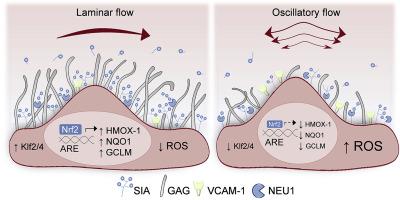Redox Biology ( IF 10.7 ) Pub Date : 2020-11-28 , DOI: 10.1016/j.redox.2020.101816 Paraskevi-Maria Psefteli 1 , Phoebe Kitscha 1 , Gema Vizcay 2 , Roland Fleck 2 , Sarah J Chapple 1 , Giovanni E Mann 1 , Mark Fowler 3 , Richard C Siow 1

|
Activation of the nuclear factor erythroid 2–related factor 2 (Nrf2) pathway is critical for vascular endothelial redox homeostasis in regions of high, unidirectional shear stress (USS), however the underlying mechanosensitive mediators are not fully understood. The endothelial glycocalyx is disrupted in arterial areas exposed to disturbed blood flow that also exhibit enhanced oxidative stress leading to atherogenesis. We investigated the contribution of glycocalyx sialic acids (SIA) to Nrf2 signaling in human endothelial cells (EC) exposed to atheroprotective USS or atherogenic low oscillatory shear stress (OSS). Cells exposed to USS exhibited a thicker glycocalyx and enhanced turnover of SIA which was reduced in cells cultured under OSS. Physiological USS, but not disturbed OSS, enhanced Nrf2-mediated expression of antioxidant enzymes, which was attenuated following SIA cleavage with exogenous neuraminidase. SIA removal disrupted kinase signaling involved in the nuclear accumulation of Nrf2 elicited by USS and promoted mitochondrial reactive oxygen species accumulation. Notably, knockdown of the endogenous sialidase NEU1 potentiated Nrf2 target gene expression, directly implicating SIA in regulation of Nrf2 signaling by USS. In the absence of SIA, deficits in Nrf2 responses to physiological flow were also associated with a pro-inflammatory EC phenotype. This study demonstrates that the glycocalyx modulates endothelial redox state in response to shear stress and provides the first evidence of an atheroprotective synergism between SIA and Nrf2 antioxidant signaling. The endothelial glycocalyx therefore represents a potential therapeutic target against EC dysfunction in cardiovascular disease and redox dyshomeostasis in ageing.
中文翻译:

糖萼唾液酸通过人内皮细胞中的流体剪切应力调节 Nrf2 介导的信号传导
核因子红细胞 2 相关因子 2 (Nrf2) 通路的激活对于高单向剪切应力 (USS) 区域的血管内皮氧化还原稳态至关重要,但其潜在的机械敏感介质尚不完全清楚。暴露于血流紊乱的动脉区域的内皮糖萼被破坏,氧化应激也增强,导致动脉粥样硬化。我们研究了暴露于动脉粥样硬化 USS 或致动脉粥样硬化低振荡剪切应力 (OSS) 的人内皮细胞 (EC) 中糖萼唾液酸 (SIA) 对 Nrf2 信号传导的贡献。暴露于 USS 的细胞表现出更厚的糖萼和增强的 SIA 周转率,而在 OSS 下培养的细胞则减少了 SIA 周转率。生理性 USS(但未干扰 OSS)增强了 Nrf2 介导的抗氧化酶的表达,而这种表达在用外源神经氨酸酶进行 SIA 裂解后减弱。 SIA 的去除破坏了参与 USS 引发的 Nrf2 核积累的激酶信号传导,并促进了线粒体活性氧的积累。值得注意的是,内源唾液酸酶 NEU1 的敲低增强了 Nrf2 靶基因的表达,直接暗示 SIA 参与 USS 对 Nrf2 信号传导的调节。在没有 SIA 的情况下,Nrf2 对生理血流反应的缺陷也与促炎性 EC 表型相关。这项研究表明,糖萼响应剪切应力调节内皮氧化还原状态,并提供了 SIA 和 Nrf2 抗氧化信号之间的动脉粥样硬化保护协同作用的第一个证据。因此,内皮糖萼代表了针对心血管疾病中的 EC 功能障碍和衰老中的氧化还原稳态失调的潜在治疗靶点。









































 京公网安备 11010802027423号
京公网安备 11010802027423号